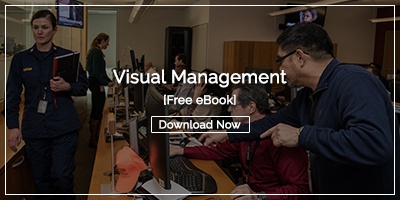 Idea boards are a helpful visual management technique. They help keep improvement work front and center and make it easy for everyone to recognize progress. However, there are some pretty significant limits to the usefulness of physical idea boards hanging on a wall.
Idea boards are a helpful visual management technique. They help keep improvement work front and center and make it easy for everyone to recognize progress. However, there are some pretty significant limits to the usefulness of physical idea boards hanging on a wall.
We've seen a widespread digital transformation that has idea boards transitioning from the wall to the cloud. Idea board software has many advantages over the bulletin board and sticky notes approach.
Here are a few of the most significant benefits.
Digital idea boards support distributed and remote teams
Physical idea boards are great if you happen to be in the room where they are located, but they are not so valuable when you have teams working from different locations or employees who form home occasionally. Given the reality of COVID19 precautions, remote and hybrid work is more common than ever. A virtual idea board is visible and actionable from anywhere.
Idea board software allows organizations to preserve the benefits of visual management, like gathering in a common space and facilitating conversation - but also supports the inclusion of people in other locations who can all see the same thing simultaneously.
Even if your team has no remote workers and everyone gathers in the same space every day, there is still an advantage to a virtual idea board. You never know when someone might get a great idea after hours or on the weekend. With a mobile app, they can input their thought before they forget or get distracted the next day.
Information is shared in real-time
Another benefit of an online improvement and idea board is that as soon as someone enters a new suggestion or updates a work-in-progress, the information is available to everyone who needs it in real-time. So, rather than waiting for someone with an opportunity for improvement to make their way to a physical board to submit the idea and then waiting for others to find their way to see it, ideas and information are shared on the fly.
Leaders have access to multiple boards
Ideally, continuous improvement is baked into the culture of an organization. It is spread widely enough that each functional area has one or more idea boards in play at all times. Idea management software makes it easy for leaders to have real-time and profound insight into the state of change across departments or teams. They can click between locations and teams to see their individual idea boards and drill down into the areas that need support and coaching.
Improvement projects are part of the tribal knowledge
Perhaps the biggest drawback of physical idea boards is that they only provide a snapshot view of improvement work. That's useful but misses the opportunity to capture the lessons learned, and best practices revealed as each project is complete. With software, you can digitize and store all documents, images, conversations, and revelations about each improvement for future reference and training. In addition, your digital idea boards include all completed initiatives, which you can click on to drill down into the details of the process and results. These initiatives show up in database searches as well, ensuring that people know when they're working on duplicate efforts and enabling them to benefit from past lessons learned.
Every brainstorming session is a gold mine
A brainstorming session aims not to come up with the "right" answer to solve a problem but rather to open up space for everyone to suggest even the wildest ideas. Ideally, the team will use the time to understand the root cause of the issue better and get creative about how it might be resolved. Most ideas in a brainstorming session will ultimately be rejected, but that doesn't mean they have no value. On the contrary, if you capture them in your idea management tool, you may find they have future value when applied to a different problem or improvement.
Knowledge is shared, and improvement spreads
Process improvements that get positive results in one department may apply to others. Electronic idea boards make it easy for folks from different functional areas and teams to see what is working and replicate success where it makes sense. As a result, your team's improvement methods get better and better over time.
Front line and strategic goals are aligned
The promise of continuous improvement is that small changes will set the stage for reaching a breakthrough, game-changing strategic objectives. This is most likely when the goals of the organization and each individual are closely aligned. When an opportunity for improvement is added to an idea board, it should be viewed in context with the bigger picture. Idea management software includes functionality that helps goals cascade down to departments, teams, and individual employees for maximum alignment and synchronized progress.
Notifications and alerts ensure forward motion
One significant disadvantage of a physical idea board is that it is passive. It doesn't incite action but instead waits for team members to pay attention to it. Idea management software adds an element of interruption to remind people when action is required and alerts managers when tasks are missed, or challenges arise. We all get busy and pulled in a bunch of different directions, so it is helpful to have a solution that pulls people's attention back to improvement work when necessary.
Success broadcasting generates engagement
When we ask people about how they use idea boards, most focus on how they gather and implement ideas for improvement. That's critical, but too often, the importance of celebrating success is overlooked. Our clients have found that when they broadly share the results of successful improvement projects, they see a spike in engagement and ideas from other employees. People like to be recognized and gladly participate in work that earns positive attention.
You can quantify long-term results
Some improvements are pass/fail projects that either show immediate payback or not. However, many ideas for positive change produce quantifiable results over the long term. For example, a cost reduction project may pay dividends over months or even years. Calculating the long-term effects of improvement work is vital because it makes it a no-brainer for leaders to continue investing in improvement activities and enacting employee ideas. For employees, it demonstrates the power of bottom-up innovation and helps keep people excited about finding the next great idea.
The investment demonstrates the importance of employee ideas
Some have said that budgets are values documents. In other words, leaders invest in things they think are important. Employees recognize this reality and take cues about prioritizing their efforts based on where they see leadership investment. By carving out the budget for idea board software, leaders signal to the organization that they care deeply about gathering and acting on employee ideas for improvement. The result is increased engagement, better follow-through, and a more significant impact.
Idea boards are a vital tool for modern managers and leaders. Deploying a cloud-based software solution makes them more impactful and helps engage a bigger crowd. You can't go wrong if you look for a solution with a mobile application, robust reporting, top-down and bottom-up management, and built-in success broadcasting. If you like the thought of having your idea board visible in the workspace, the best software solutions include wallboards that can display information updated in real-time wherever you like.




Add a Comment